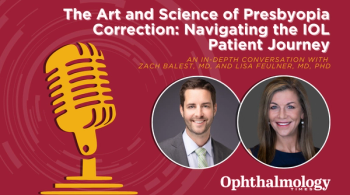
Devices changing glaucoma surgery equation
Surgical treatment for glaucoma already offers good efficacy, but adverse event rates remain too high for routine use in mild-to-moderate disease. New devices promise to change that equation, said Ike K. Ahmed, MD, FRCSC, assistant professor, University of Toronto, Ontario.
â¨San Francisco-Surgical treatment for glaucoma already offers good efficacy, but adverse event rates remain too high for routine use in mild-to-moderate disease. New devices promise to change that equation, said Ike K. Ahmed, MD, FRCSC, assistant professor, University of Toronto, Ontario.
“We see three trends in treatment,” said Dr. Ahmed during the Glaucoma 360 New Horizons Forum on Friday. “Med-heavy treatment is moving toward intervention, macro procedures are moving to micro, and open systems are moving to closed.”
Among key surgical technologies highlighted:
- AqueSys is developing Xen, a soft, permanent gelatin stent implant that drains into the subconjunctival space. The microstent shows a 30% reduction from best medicated IOP and a 50% to 60% reduction in medication use, said President and Chief Executive Officer (CEO) Ron Bache. Improvements are stable to at least 3 years.
- Glaukos is marketing the iStent, a permanent microstent that bypasses the trabecular meshwork and opens a pathway into Schlemm’s canal. Mike Neilon, vice president, international, added that the company has other devices in 18 concurrent trials with more than 4,000 patients.
- InnFocus is testing the MIDI Arrow, a biocompatible shunt that drains excess fluid. Clinical trials show a median IOP of 10.6 mm Hg at 1 year post implant and 11.1 after 2 years. At 1 year, 89% of patients are at or below 14 mm Hg at 1 year and 92% at 2 years, said Leonard Pinchuk, PhD, DSc, co-founder, president, and CEO.
- Ivantis is developing Hydrus, an intracanalicular scaffold implanted into Schlemm’s canal during cataract surgery. The company is conducting head-to-head trials against the iStent, said Brett Trauthen, Ivantis chief scientific officer.
- Sensimed is developing Triggerfish, a 24-hour pressure sensor worn like a contact lens. The device measures IOP over a 24-hour period to help clinicians personalize medication and dosing to match variations in IOP, said CEO Jean Marc Wismer, MScEE, MBA.
- Transcend Medical is developing the CyPass microstent that drains into the suprachoroidal space. The company will report final results in 505 patients later this year, said Sean Ianchulev, MD, MPH, chief medical officer.
Newsletter
Don’t miss out—get Ophthalmology Times updates on the latest clinical advancements and expert interviews, straight to your inbox.


















































.png)


